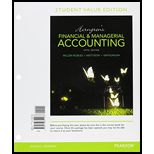
Concept explainers
1. (a)
Methods of
The three methods of depreciation are:
- Straight-line method: Under the straight-line method of depreciation, the same amount of depreciation is allocated every year over the estimated useful life of an asset.
- Units-of-production method: In this method of depreciation, the amount of depreciation is charged based on the unit of production each year.
- Double-declining balance method: In this method of depreciation, the diminishing value of the asset is taken into consideration for determining the depreciation for the succeeding years.
To Compute: the amount of depreciation for the first year for A Company under the straight-line method
(b)
To Compute: the amount of first-year depreciation under the units-of- production method.
(c)
To Compute: the amount of first-year depreciation under the double-declining-balance method.
2.
To Show: the book value of the airplane of A Company under the three methods.
Want to see the full answer?
Check out a sample textbook solution
Chapter 9 Solutions
Horngren's Financial & Managerial Accounting, Student Value Edition Plus MyLab Accounting with Pearson eText -- Access Card Package (5th Edition)
- Can you solve this general accounting problem using accurate calculation methods?arrow_forwardCould you explain the steps for solving this financial accounting question accurately?arrow_forwardFinancial Accounting Question: A new common stock issue that paid a $1.77 dividend last year. The par value of the stock is $15, and the firm's dividends per share have grown at a rate of 7.8% per year. The growth rate is expected to continue in the foreseeable future. The price of this stock is now 27.33. The cost of common equity for the firm is %. Answer: 14.78%arrow_forward
- Principles of Accounting Volume 1AccountingISBN:9781947172685Author:OpenStaxPublisher:OpenStax College
 College Accounting, Chapters 1-27AccountingISBN:9781337794756Author:HEINTZ, James A.Publisher:Cengage Learning,
College Accounting, Chapters 1-27AccountingISBN:9781337794756Author:HEINTZ, James A.Publisher:Cengage Learning, EBK CONTEMPORARY FINANCIAL MANAGEMENTFinanceISBN:9781337514835Author:MOYERPublisher:CENGAGE LEARNING - CONSIGNMENT
EBK CONTEMPORARY FINANCIAL MANAGEMENTFinanceISBN:9781337514835Author:MOYERPublisher:CENGAGE LEARNING - CONSIGNMENT  Intermediate Accounting: Reporting And AnalysisAccountingISBN:9781337788281Author:James M. Wahlen, Jefferson P. Jones, Donald PagachPublisher:Cengage Learning
Intermediate Accounting: Reporting And AnalysisAccountingISBN:9781337788281Author:James M. Wahlen, Jefferson P. Jones, Donald PagachPublisher:Cengage Learning Financial Accounting: The Impact on Decision Make...AccountingISBN:9781305654174Author:Gary A. Porter, Curtis L. NortonPublisher:Cengage Learning
Financial Accounting: The Impact on Decision Make...AccountingISBN:9781305654174Author:Gary A. Porter, Curtis L. NortonPublisher:Cengage Learning





